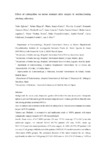Mostrar o rexistro simple do ítem
Effect of cabergoline on tumor remnant after surgery in nonfunctioning pituitary adenoma
| dc.contributor.author | Iglesias, Pedro | |
| dc.contributor.author | Biagetti, Betina | |
| dc.contributor.author | Araújo-Castro, Marta | |
| dc.contributor.author | Alcázar, Victoria | |
| dc.contributor.author | Guerrero-Pérez, Fernando | |
| dc.contributor.author | Rivero, Noelia | |
| dc.contributor.author | Casteràs, Anna | |
| dc.contributor.author | García Izquierdo, Belén | |
| dc.contributor.author | García Gómez, Carlos | |
| dc.contributor.author | Viedma Torres, Víctor | |
| dc.contributor.author | Pascual-Corrales, Eider | |
| dc.contributor.author | Pavón, Isabel | |
| dc.contributor.author | Villabona, Carles | |
| dc.contributor.author | Cordido, Fernando | |
| dc.contributor.author | Díez, Juan J. | |
| dc.date.accessioned | 2023-01-23T08:43:19Z | |
| dc.date.issued | 2022-11-10 | |
| dc.identifier.citation | Iglesias P, Biagetti B, Araujo-Castro M, Alcázar V, Guerrero-Pérez F, Rivero N, Casteràs A, Gómez CG, Izquierdo BG, Torres VV, Pascual-Corrales E, Pavón I, Villabona C, Cordido F, Díez JJ. Effect of cabergoline on tumor remnant after surgery in nonfunctioning pituitary adenoma. J Neurooncol. 2022 Nov;160(2):351-359. | es_ES |
| dc.identifier.issn | 0167-594X | |
| dc.identifier.uri | http://hdl.handle.net/2183/32378 | |
| dc.description.abstract | [Abstract] Background: In recent years, dopamine agonists (DAs) have become an attractive therapeutic option to prevent both tumor growth and post-surgical tumor remnant growth in clinically non-functioning pituitary adenoma (NFPA). Aim: To analyze our experience on the effect of cabergoline (CAB) on tumor remnant after initial surgery in NFPA patients. Patients and methods: A retrospective and multicenter study of NFPA patients with tumor remnant after surgery treated with CAB was performed. Results: From a total of 142 NFPA patients (79 men, 55.2%; mean age 57.2 ± 14.2 year) who underwent surgery, we selected 62/142 (43.7%) patients (32 men, 51.6%; mean age 59.3 ± 13.9 year) with tumor persistence (TP) after surgery. In 22/62 (35.5%) TP patients CAB was used (CAB group), while the rest of the patients (40/62, 64.5%) underwent active surveillance [observation (OBS) group)]. The maximum diameter of the tumor remnant did not change significantly in either the CAB group [11.5 (6.0-16.9) mm vs. 12.0 (7.0-15.0) mm, p = 0.85) or the OBS group [8.5 (6.0-13.7) mm vs. 9.0 (6.2-14.0) mm, p = 0.064) at the end of the follow-up [13 (10.5-17) vs. 77.5 (50.2-107.2) months, CAB vs. OBS group; p < 0.001]. At the end of the treatment period with CAB most of the patients (n = 20/22, 90.9%) showed no progression of the tumor remnant [stable disease, SD (n = 17/22, 77.2%) and partial response, PR (n = 3/22, 13.6%)], while 2/22 patients (9.1%) exhibited progression. Similar response rates were observed in the OBS group [SD (n = 32/40, 80%), PR (n = 2/40, 5%), and progression (n = 6/40, 15%)]. Although no statistically significant differences (p = 0.42) were found in these responses, the percentage of progression was 1.65 times higher in the OBS group compared to the CAB group. On the contrary, the percentage of PR was 2.72 times higher in the CAB group compared to the OBS group, despite a significantly shorter follow-up period in the CAB group. Conclusion: Although the present study showed no significant differences in the type of tumor response between the CAB and OBS groups of patients, the percentage of PR was higher and that of progression lower in the CAB group compared to the OBS group. This finding does not rule out a potential therapeutic benefit of CAB in the management of tumor remnant in patients with NFPA undergoing surgery. | es_ES |
| dc.language.iso | eng | es_ES |
| dc.publisher | Springer | es_ES |
| dc.relation.uri | https://doi.org/10.1007/s11060-022-04149-7 | es_ES |
| dc.rights | This version of the article has been accepted for publication, after peer review and is subject to Springer Nature’s AM terms of use, but is not the Version of Record and does not reflect post-acceptance improvements, or any corrections. The Version of Record is available online at Springer Link web page. | es_ES |
| dc.subject | Cabergoline | es_ES |
| dc.subject | Dopamine agonists | es_ES |
| dc.subject | Efficacy | es_ES |
| dc.subject | Nonfunctioning pituitary adenoma | es_ES |
| dc.subject | Safety | es_ES |
| dc.subject | Therapeutic outcome | es_ES |
| dc.title | Effect of cabergoline on tumor remnant after surgery in nonfunctioning pituitary adenoma | es_ES |
| dc.type | info:eu-repo/semantics/article | es_ES |
| dc.rights.access | info:eu-repo/semantics/embargoedAccess | es_ES |
| dc.date.embargoEndDate | 2023-11-10 | es_ES |
| dc.date.embargoLift | 2023-11-10 | |
| UDC.journalTitle | Journal of Neuro-Oncology | es_ES |
| UDC.volume | 160 | es_ES |
| UDC.issue | 2 | es_ES |
| UDC.startPage | 351 | es_ES |
| UDC.endPage | 359 | es_ES |






